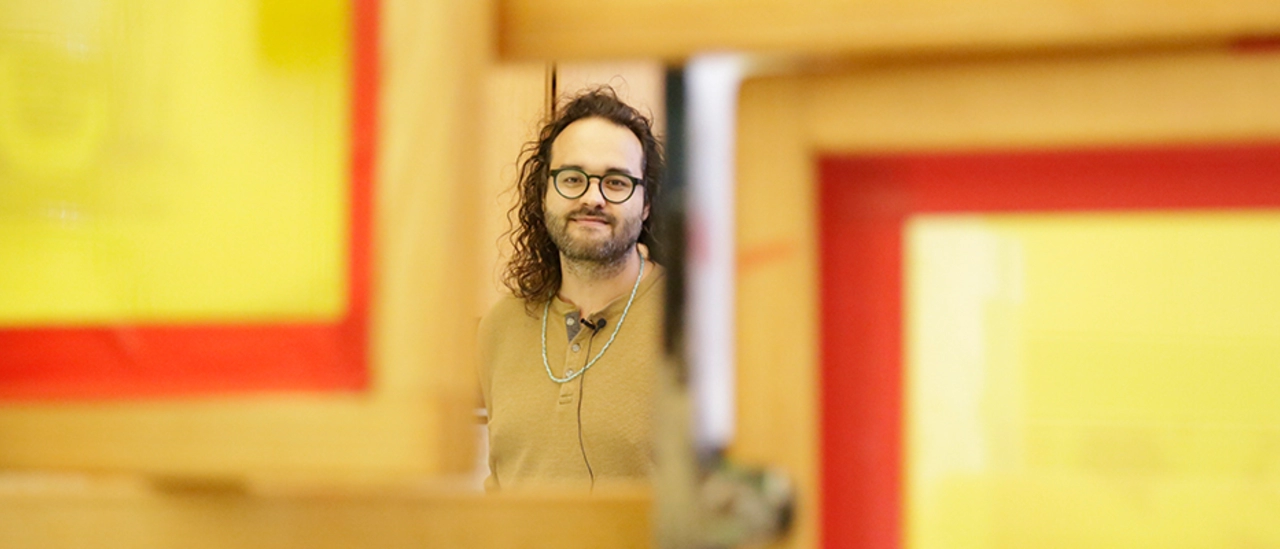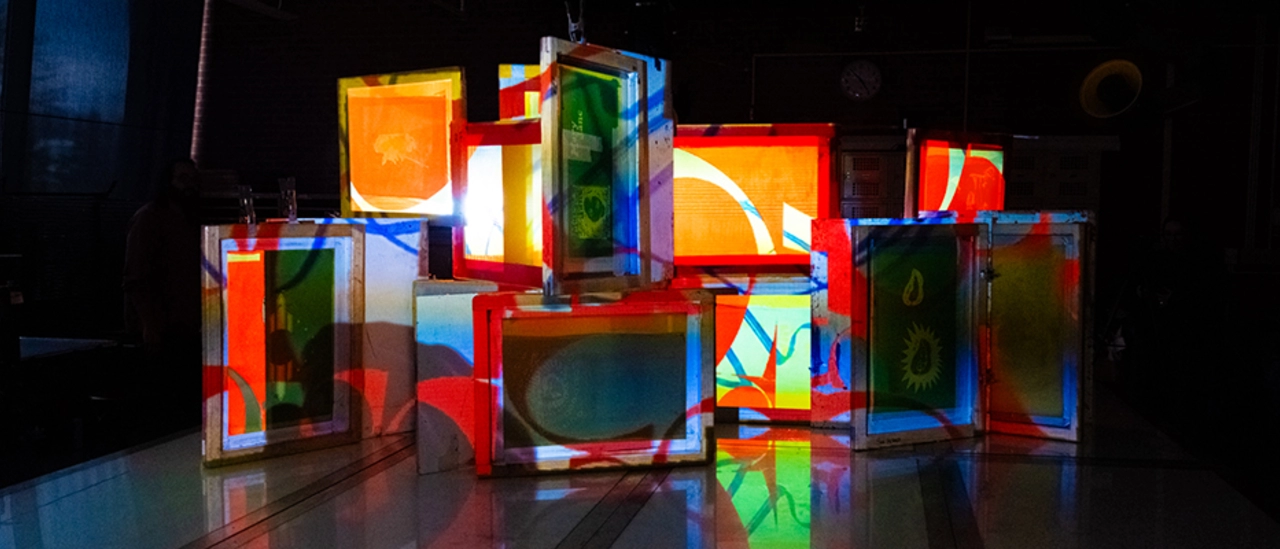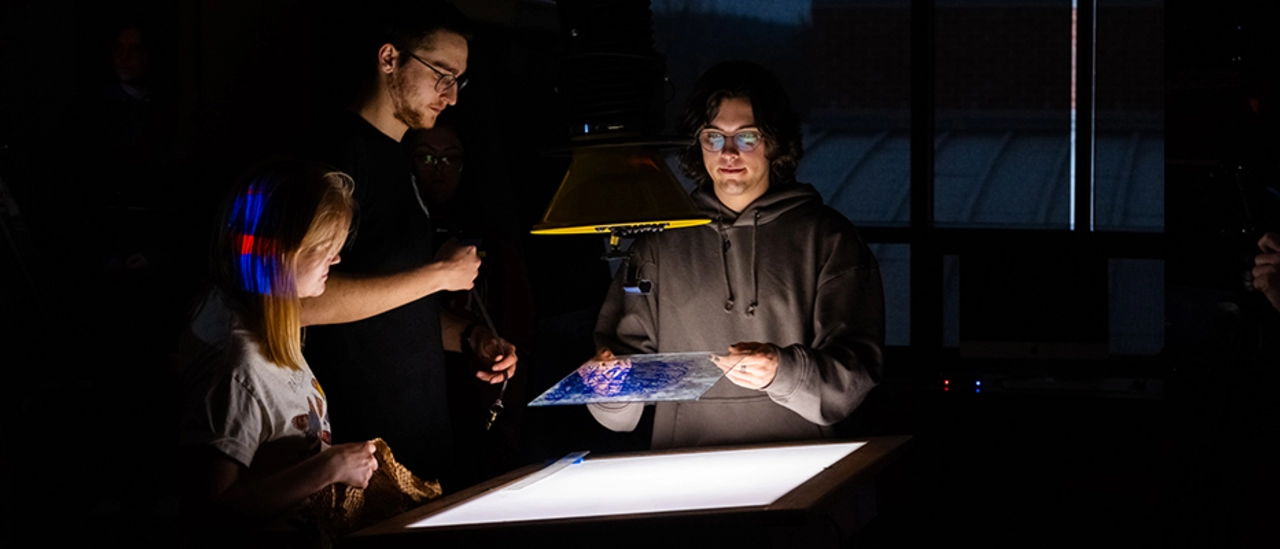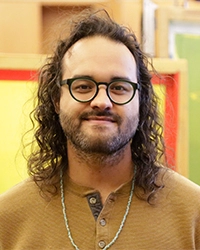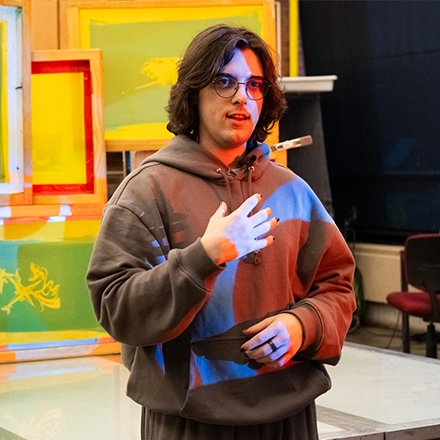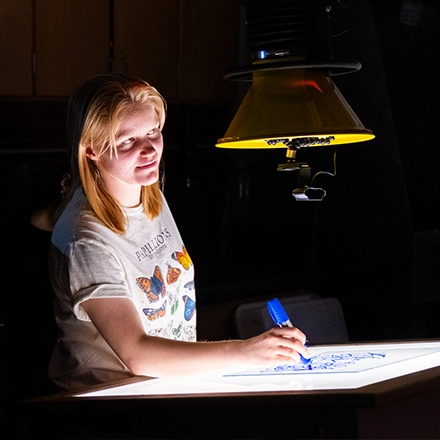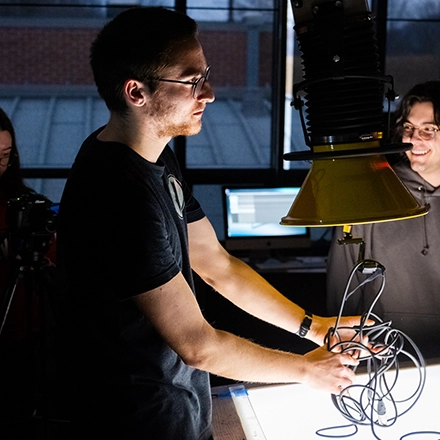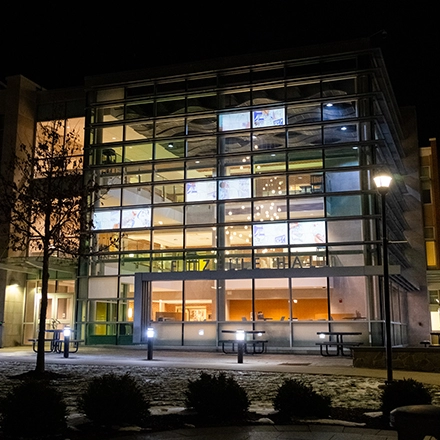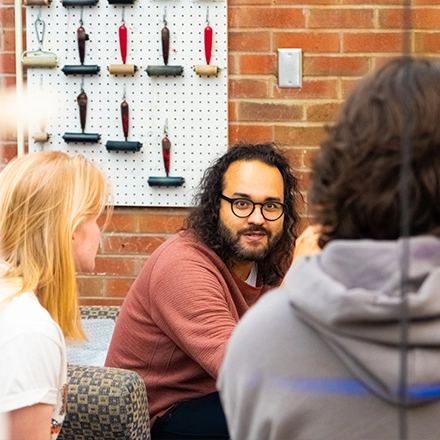SUNY Oneonta’s second Artist-in-Residence program will culminate in two giant multimedia installations on the glass windows of Fitzelle Hall and the exterior of the Fine Arts building, co-created by collaborative artist Natan Diacon-Furtado and three student interns.
A visual artist driven by collaboration, interaction and mutual learning, Diacon-Furtado leaves SUNY Oneonta after eight weeks of bringing students, faculty and staff together to create sculptural work that combines visual and audio components with audience participation. What began as a dream at the beginning of the semester quickly developed into a dynamic, evolving art series made possible by the collaborative efforts of Diacon-Furtado, Digital and Studio Art major Bird Wallace and Art and Design majors Victoria Hallenbeck and Clayton Davis. The three seniors interned with Diacon-Furtado from the beginning of their spring 2024 semester through the artist’s final day-in-residence on March 13.
“They’re the reason that this piece behind us works,” said Diacon-Furtado, gesturing to a colorful multimedia installation tilted “Pattern Offerings” inside the Fine Arts 318 studio. This first installation was on display in Fine Arts 318 during the majority of the visual artist’s residency, and it helped Diacon-Furtado and the three interns create the final two pieces.
“My work is driven by interaction, collaboration and learning from each other. I seek out fellowships and residencies like this time I’ve spent at SUNY Oneonta so I can do that,” said Diacon-Furtado. “I don’t want to work with people my age who think like me and are like me. I want to do it with a wide range of folks, and so working with the student interns has been wonderful for that exact reason – because we get to co-create in a way where it’s not just my brain bringing ideas to the table. That’s how we ended up with something like this project that is so fluid and dynamic.”
“Pattern Offerings”
As the School of Liberal Arts and Business (SLAB) Artist-in-Residence, Diacon-Furtado’s role at SUNY Oneonta was to develop new artistic ideas and work with students to bring those ideas to fruition. Together, Diacon-Furtado and the student interns created three site-specific projects to be presented inside Fitzelle Hall and projected on the Fine Arts building.
“Pattern Offerings” is a two-part, real-time projection sculptural installation designed by using multiple pieces of hardware, software and a newly developed projection mapping technique created by Wallace and Diacon-Furtado. Dubbed “Bird Boxing,” the projection mapping technique allows the shapes of various items recorded by the webcam fixed above the lighting table to be projected onto the various planes set up in the studio through multiple projectors using Online Broadcast Software (OBS). This technique allowed a dozen classes to contribute to the final design of “Pattern Offerings” throughout Diacon-Furtado’s residency.
“The projection maps make it so they're not leaking light everywhere, and it makes it feel like it's one actual object and that that actual object is moving,” Diacon-Furtado explained. “You kind of lose track of the fact that the panes are being used as projection screens because it feels like one cohesive sculpture. The eye of the recording portion is just a webcam and a light table. The light table gives us a source of backlighting, and the webcam gives us the eye and the visuals, and it runs back through this cable into one of the laptops.”
The visual component of “Pattern Offerings” was only part of what made the piece so uniquely designed. A contact microphone captured all sound and vibrations generated on the light table when contributors moved items around it. Thanks to Davis’s breadth of knowledge in audio production, the piece’s audio component complemented the visuals and was just as interactive. Davis also put together a two-minute looped audio track, all recorded on a synthesizer and mixed in with bass.
“If you were in the room when the audio was active, it sounds amazing,” said Wallace. “Clayton did a great job with designing it. Victoria, Natan and I messed with the projectors to figure out different shapes and ways to interact with everything. It has been really cool to see all these weird shapes and silhouettes interacting with each other. This internship will influence me from here on out to make more abstract or interesting artwork.”
Behind the scenes of the first part of “Pattern Offerings,” Hallenbeck was instrumental in ensuring every interaction with the piece was properly recorded and saved. On April 4, around 7 p.m., the second part of “Pattern Offerings” will be projected onto the exterior of the Fine Arts building. This projection will showcase large-scale, artistic collaboration via an edited recording of every interaction conducted by the 12 visiting classes.
“Collaborative Monumentality”
The final installation created by Diacon-Furtado and the three interns is called “Collaborative Monumentality” and features two pre-recorded videos of the artists projected onto 11 different windows that give the appearance of the artists coloring in each window. Like the exterior display of “Pattern Offerings”, this installation is best viewed in the evening to see the projection.
“All of the windows contain a semi-transparent film, and there are eight windows on the front and three around the side of Fitzelle Hall used for ‘Collaborative Monumentality,’” said Hallenbeck. “The projected windows will remain the same for the duration of the installation, and the four projectors fit tediously and perfectly to their corresponding windows. Each window has its own video, and each video plays through, plays in reverse, gets to the beginning, and then starts again.”
One of the unique design choices for “Collaborative Monumentality” is that each projector maps to a cluster of windows. Two projectors map to two windows, one maps to three windows and the remaining projector maps to four windows.
“Victoria has been amazingly helpful with the Fitzelle and Fine Arts exterior installations because she's very “no-nonsense” when it comes to technology usage,” said Diacon-Furtado. “She helped us figure out how little technology we need between a human and what will be projected onto the windows – making something that is both collaborative and monumental.”
Although Diacon-Furtado’s final day as the SLAB Artist-in-Residence was March 13, their impact will extend far beyond the eight-week residency, helping Davis, Hallenbeck and Wallace understand the value of collaboration in art.
“Natan really emphasized collaboration, and I think that is super important with artists, and being able to work together with a group of people is amazing,” said Davis. “You're able to get a lot better experiences than just doing things on your own, and you get a lot of outside perspectives rather than just everything within your brain.”
